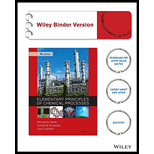
Concept explainers
(a)
Interpretation:
A flowchart for the given process is to be drawn and labelled. The validation of the given statement that subsystem containing the point where the bypass stream splits off from the evaporator feed has one degree of freedom is to be stated. The degree of freedom analysis for the overall system, the evaporator, bypass-evaporator product and the mixing point is to be predicted. The equations to determine all unknown stream variable are to be shown. The variable in each equation is to be circled.
Concept introduction:
The evaporation is a process that aids in the conversion of a liquid into gas due to rise in temperature. The process of evaporation becomes faster with the increase in surface area because it permits the liquid molecules to acquire more heat. It results in the increase in kinetic energy of molecules, which aids to overcome of attractive forces between molecules of liquid.
In reverse osmosis, the solvent passes in the opposite direction to that of osmosis.
(b)
Interpretation:
The amount of product produced per
Concept introduction:
The evaporation is a process that aids in the conversion of a liquid into gas due to rise in temperature. The process of evaporation becomes faster with the increase in surface area because it permits the liquid molecules to acquire more heat. It results in the increase in kinetic energy of molecules, which aids to overcome of attractive forces between molecules of liquid.
In reverse osmosis, the solvent passes in the opposite direction to that of osmosis.
(c)
Interpretation:
The possible drawbacks for the given proposal are to be stated.
Concept introduction:
The evaporation is a process that aids in the conversion of a liquid into gas due to rise in temperature. The process of evaporation becomes faster with the increase in surface area because it permits the liquid molecules to acquire more heat. It results in the increase in kinetic energy of molecules, which aids to overcome of attractive forces between molecules of liquid.
In reverse osmosis, the solvent passes in the opposite direction to that of osmosis.
Learn your wayIncludes step-by-step video

Chapter 4 Solutions
Elementary Principles of Chemical Processes 4e Binder Ready Version + WileyPLUS Registration Card (Wiley Plus Products)
- Write the molecular formula for a compound with the possible elements C, H, N and O that exhibits a molecular ion at M* = 128.0632. Exact Masses of the Most Abundant Isotope of Selected Elements Isotope Natural abundance (%) Exact mass 1H 99.985 12C 98.90 14N 99.63 160 99.76 Molecular formula 1.008 12.000 14.003 15.995 (In the order CHNO, with no subscripts)arrow_forwardCan I please get help with this? And can I please the lowest possible significant number?arrow_forwardWhat is the molar mass of a gas that takes three times longer to effuse than helium?arrow_forward
- First image: I have to show the mecanism (with arows and structures) of the reaction at the bottom. Also I have to show by mecanism why the reaction wouldn't work if the alcohol was primary Second image: I have to show the mecanism (with arrows and structures) for the reaction on the left, where the alcohol A is added fast in one portion its not an examarrow_forwardwhat is the skeletal structure of a tertiary alkyl fluoride with six carbon atoms and no rings.arrow_forwardOne step of glycolysis is a retro-aldol reaction (aldolase) to produce ATP.Below is the aldol reaction of the equilibrium. Show the mechanism for the base catalyzed reaction. *see imagearrow_forward
 ChemistryChemistryISBN:9781305957404Author:Steven S. Zumdahl, Susan A. Zumdahl, Donald J. DeCostePublisher:Cengage Learning
ChemistryChemistryISBN:9781305957404Author:Steven S. Zumdahl, Susan A. Zumdahl, Donald J. DeCostePublisher:Cengage Learning ChemistryChemistryISBN:9781259911156Author:Raymond Chang Dr., Jason Overby ProfessorPublisher:McGraw-Hill Education
ChemistryChemistryISBN:9781259911156Author:Raymond Chang Dr., Jason Overby ProfessorPublisher:McGraw-Hill Education Principles of Instrumental AnalysisChemistryISBN:9781305577213Author:Douglas A. Skoog, F. James Holler, Stanley R. CrouchPublisher:Cengage Learning
Principles of Instrumental AnalysisChemistryISBN:9781305577213Author:Douglas A. Skoog, F. James Holler, Stanley R. CrouchPublisher:Cengage Learning Organic ChemistryChemistryISBN:9780078021558Author:Janice Gorzynski Smith Dr.Publisher:McGraw-Hill Education
Organic ChemistryChemistryISBN:9780078021558Author:Janice Gorzynski Smith Dr.Publisher:McGraw-Hill Education Chemistry: Principles and ReactionsChemistryISBN:9781305079373Author:William L. Masterton, Cecile N. HurleyPublisher:Cengage Learning
Chemistry: Principles and ReactionsChemistryISBN:9781305079373Author:William L. Masterton, Cecile N. HurleyPublisher:Cengage Learning Elementary Principles of Chemical Processes, Bind...ChemistryISBN:9781118431221Author:Richard M. Felder, Ronald W. Rousseau, Lisa G. BullardPublisher:WILEY
Elementary Principles of Chemical Processes, Bind...ChemistryISBN:9781118431221Author:Richard M. Felder, Ronald W. Rousseau, Lisa G. BullardPublisher:WILEY





